Bio
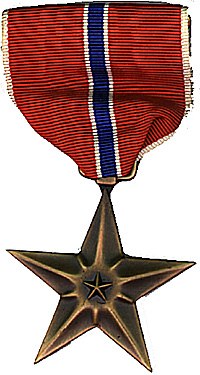 PFC Joseph H. Ortiz, Cannon Co., 354th Infantry Regt, 89th Division, 3rd Army, was awarded the Bronze Star medal (at right) on April 19, 1948 for actions occuring on April 10, 1945 during the Rhineland Campaign. He had been drafted April 1, 1944, spent four months in basic training, six months as a rifleman, and 11 months as a lineman. He was immunized for small pox on April 18, 1944, tetanus on October 30, 1944, and typhoid on December 12, 1945.
PFC Joseph H. Ortiz, Cannon Co., 354th Infantry Regt, 89th Division, 3rd Army, was awarded the Bronze Star medal (at right) on April 19, 1948 for actions occuring on April 10, 1945 during the Rhineland Campaign. He had been drafted April 1, 1944, spent four months in basic training, six months as a rifleman, and 11 months as a lineman. He was immunized for small pox on April 18, 1944, tetanus on October 30, 1944, and typhoid on December 12, 1945.
According to Ortiz's Qualification Record, a lineman "laid wires for telephone and telegraph communications, made connection between gun battery and operation post for directing artillery fire, spliced cable, mended broken connections, and repaired and replaced defective parts."
He departed for Europe on January 10, 1945, arriving on January 21 at Le Havre, and then on to Camp Lucky Stripe, 40 miles inland. On February 12, he departed Rouen on the 17:20 train to Brussels. By mid-March, he was part of CT-4, in reserve near Igel, by the Moselle River. By the end of March, he was across the Rhine. On April 10th, he was in action at Ohrdruf.
Eye-witness Accounts
Here are the two eye-witness accounts transcribed from the originals.
-
"We pulled into the town of Ohrdruf, Germany in the morning. Our guns continued on to a position outside of the town. Captain Gaylor was looking for a CP when all at once, 88 firing started. He then decided to havethe CP in a more covered place in town. The wiremen by this time had arrived on the edge of town about a distance of a half a mile. Captain Gaylor instructed them to take cover until he notified then where the CP would be. At this time, we called back to the guns and asked Pfc. Ehrlich to meet us with more wire. By the time he arrived, we had received instruction as to where the CP was and we then started into the town. We took advantage of all possible cover as we noted that all the line company were in the ditches, cellars, and houses as the 88 firing was so heavy at the time. A Lt. from one of the line companies told us to take cover and asked us if we were crazy. We stopped for a minute or two, then Pfc Ehrlich suggested going on as the only way to stop the firing was to get the wire in and our guns in action. Pfc Ortiz without hesitation continued on with us and we continued to the square a distance of about 300 yards, where we prepared ourselves for the dash across the square, which was open and where we saw two of the linemen had been hit and were getting first aid. We got the wire across the square safely and continued taking advantage of all possible cover and finally got the wire to the CP about a half a mile from the square. Our guns opened up soon after and the line companies started to move again."
Cannon Co. 354 Infantry
"The cannons and trucks pulled into the town of Ohrdruf, Germany in the AM of April 10. The guns continued out of town about a half mile and set up. The wiremen started laying wire from the guns to the edge of town when suddenly 88 fire broke out, and they were ordered by Captain Gaylor to take cover as he had decided to change the location of the CP deeper in the town for better and safer coverage. The wiremen then called by phone back to me and asked me to meet them at the crossroads with more wire. The distance was about a half a mile, when I reached them they had received the location of the CP. So we all took off at once taking advantage of any cover we could as the shelling was heavy and we noticed that the line companies were taking cover in the ditch, cellars of houses, and were at a stand still. At one point, a Lt. from one of the line companies told us to take cover and asked if we were crazy. We stopped for a breather and when I suggested that we had better move out as the only way to stop the 88 firing and to get our guns firing was to get that wire in, Pfc. Ortiz without hesitation came along and with his help we were able to cross an open space, which was the square in the town where we noted a couple of the men receiving first aid treatment having been hit either by the 88 shelling or the small arms firing. We crossed the square a distance of about 500 yards safely, and continued another half mile or so to the CP where the order was soon sent back to the guns and they opened up. Shortly after, the 88 firing stopped and theline companies started to move out."
Cannon Co. 354 Infantry
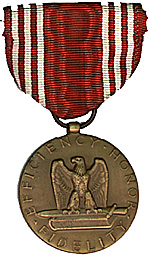 He also earned a good conduct medal (at right).
He also earned a good conduct medal (at right).
Divisional History
The following comes from the 89th Division History (Infantry Journal Press, 1947, pg. 129)
"At Ohrdruf, the 355th Regiment and the 4th Armored Division pried a scab from one of the ugliest sores when they captured the largest concentration camp liberated by American forces up to that time. It was located in a loathsome barracks area near a large army post which until the preceding December had been a German OCS training center. According to prisoner accounts the occupants of the camp, mostly slave laborers from eastern Europe, had been callously starved and beaten to death, or shot down at the whim of their SS overseers. Men who had died in the camp had been buried in a huge common pit near the barracks area. When news came of the approach of the Americans belated attempts were made to cover up the horrors of the place.
Prisoners were forced to exhume the decomposed bodies of their former comrades and cremate them on a makeshift grid of railroad rails set up near the pit. With the American armor only a few hours away the SS guards had abandoned this project in a grisly state of half-completion, machine-gunned those prisoners too ill to walk in the courtyard of the concentration compound, and had fled. One guard attempted to disguise himself as a slave laborer but as he hurried through the gate along with a few prisoners who managed to escape in the confusion he was recognized by former victims of his brutalities and was killed on the spot with a heavy truck crank.
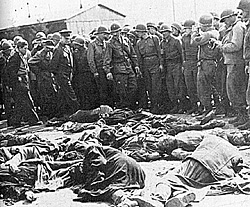 Included among the dead shot in the courtyard
when the GIs entered was the body of an American
flyer who had been brought to Ohrdruf from a Polish
prison camp and had become ill en route. He was shot
as he lay on a stretcher. Dusted over with lime, the
bodies of about forty victims of the camp were stacked
in a "beating shed," where they had died while
receiving the customary punishment for minor
infractions of rules--115 strokes on the naked back
with either a cudgel or a heavy, sharp-bladed shovel.
One of the few men ever to survive this punishment
was a German ex-convict who was employed as a
ward boss at the camp. He had been surprised by the
SS in the act of giving men under his charge more
bread than the one slice daily they were supposed to
receive. When the other German personnel in
charge of the camp fled in terror, he stayed
behind. He seemed to be getting on famously with
what few of his ex-charges remained alive. He had
been employed in German concentration camps, he
said for eleven years, and regarded Stalag Nord
Ohrdruf as one of the less severe. He estimated the
number of men buried in the common pit at 9,000.
Shortly after the arrival of the armor and infantry the
Burgermeister of Ohrdruf and his wife were
forced to visit the place. They disclaimed any definite
knovvledge of what had happened there, and
committed suicide that night.
Included among the dead shot in the courtyard
when the GIs entered was the body of an American
flyer who had been brought to Ohrdruf from a Polish
prison camp and had become ill en route. He was shot
as he lay on a stretcher. Dusted over with lime, the
bodies of about forty victims of the camp were stacked
in a "beating shed," where they had died while
receiving the customary punishment for minor
infractions of rules--115 strokes on the naked back
with either a cudgel or a heavy, sharp-bladed shovel.
One of the few men ever to survive this punishment
was a German ex-convict who was employed as a
ward boss at the camp. He had been surprised by the
SS in the act of giving men under his charge more
bread than the one slice daily they were supposed to
receive. When the other German personnel in
charge of the camp fled in terror, he stayed
behind. He seemed to be getting on famously with
what few of his ex-charges remained alive. He had
been employed in German concentration camps, he
said for eleven years, and regarded Stalag Nord
Ohrdruf as one of the less severe. He estimated the
number of men buried in the common pit at 9,000.
Shortly after the arrival of the armor and infantry the
Burgermeister of Ohrdruf and his wife were
forced to visit the place. They disclaimed any definite
knovvledge of what had happened there, and
committed suicide that night.
By April 10 the 353d completed mopping up in its zone and went into reserve at Friedrichroda, as Combat Team 4 on the right and Combat Team 5 on the left pressed the advance eastward toward the Saale River. The 3d Battalion 355th began negotiations for the surrender of Arnstadt. Lt. Albert E. Weber, Battalion S-2, acted as a peace emissary, but was told that the plans of the Supreme Command did not call for the surrender of Arnstadt. At 1300 the attack was launched and after an artillery and machine-gun duel, tank-infantry assault teams captured the town. A large labor battalion of women was freed. On the right the Germans still resisted tenaciously, augmenting their fire power with tanks and self-propelled artillery. The 1st Battalion, 354th, ran into heavy fire from high ground south of Ohrdruf and the 3d Battalion by-passed Wolfis after being held up nearly an hour by an enemy artillery concentration of over 200 rounds. These two spots were later cleared by the 87th Division.
About 1815, the 3d Battalion, 354th, approached Gossel and Lt. Glen C. Belew, Battalion S-2, volunteered to go into the town with two German civilians and demand the surrender of the place. The trio immediately was taken prisoner by about sixty SS troops. By lagging behind when the Germans withdrew, Lieutenant Belew managed to escape and brought back information that the town was no longer occupied. Later that night the village was subjected to enemy mortar and artillery bombardment.
The 2d Battalion on the left of the regimental zone took Espenfeld, reached the Gera river at Siegelbach, and on April 11 crossed the stream on a footbridge after an all-night artillery pounding. Near Witzleben the 2d Battalion ran into heavy fire from artillery, automatic, and 20mm. weapons. Company E was pinned down for six hours by heavy artillery."
Post-War
By the end of May, orders came through to go back to La Havre, where it was announced the division would be deactivated. However, before that would happen, on June 15, the 89th division (along with two others) was selected to "assist Com Z troops in the tremendous task of redeployment, that is, preparing and sending divisions, smaller units, and individuals to the United States for future service against Japan or demobilization." In other words, homecoming would be delayed.
On October 9, 1945, Col. Curtis Renfro issued a letter informing the men of the 354th, Combat Tean 4, about the point system and who goes home when. This letter stated:
Camp Lucky Strike
Normandy Assembly Area Command
APO 89 US Army
9 October 1945
Memorandum:
To: The Officers and Enlisted Men of CT-4
In view of the impending movement of the 89th Division to the zone of the Interior for subsequent deactivation, I know that many of you are wondering why you cannot return home with the Division, which you have served so faithfully.
Since the point system of separation from the service governs in the case of each individual, it is inevitable that your unit as you know it and as you fought with it will be dissolved. Low point personnel ineligible for discharge must be reassigned to other units for further service. Their places must be filled by high point men eligible to go home. This, in effect, will destroy the integrity of platoons, companies, battalions and the Combat Team. Although it is disappointing to many of you to be suddenly and unceremoniously separated from your comrades and from your units, you must realize that eventual deactivation of any victorious army is an inevitable concomitant of war. You must accept the painful processes of demobilization in the same cheerful spirit that you have accepted induction and commitment to battle.
You have bean good soldiers, you have fought a valiant fight and you have acquitted yourselves like men in all the tasks assigned to you, either on the battlefield or in connection with redeployment. Perhaps the most gruelling and thankless task of your service has been the redeployment assignment of seperating Camp Lucky Strike. Since your arrival at Camp Lucky Strike on 29 May 1945, you have planned, organized and operated the largest staging camp on the European Continent- Despite many obstacles and much privation, you have worked diligently day and night to enable the Combat Team to accomplish its mission. During the period 10 June to 8 October 1945, Le Havre port of embarkation shipped 640,784 troops to the states. Of that total, Camp Lucky Strike processed and staged 298,232 troops for the Le Havre port. This record speaks for itself.
Now, before you are separated from the Combat Team, I want to commend you for your outstanding devotion to duty and superior ability. To each one of you I extend my sincere thanks for unstinted loyalty and cooperation and wish you success in your future occupation whether it be as civilian or soldier.
--
Colonel 354th Infantry
Commanding
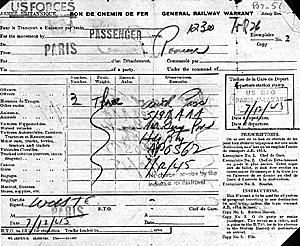
It must have been after this that he was transferred to the 377th AAA Btn "B" Battery.
On December 7, 1945, Ortiz was in Paris and boarded the 12:30 train to Rouen, evidently with two others from the 519th AAA. The "General Railway Warrant" is at right.
There is a pass dated December 18, 1945 (below) that places him in the Antwerp area.
(Note: The images scanned are the front (left) and back (right) of the pass. The army service number is purposely deleted from the image).
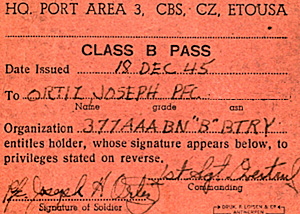 | 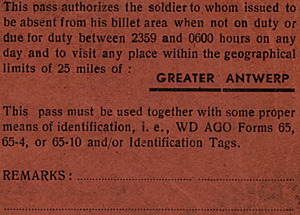 |
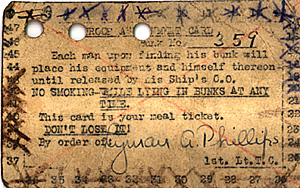 He departed Europe 8 January 1946, assigned bunk #359. The "Troop Assignment Card" specifies 359, and doubles as a meal ticket. He arrived back in the US on 28 January 1946, and was honorably discharged on 2 February 1946, Fort Dix, NJ.
He departed Europe 8 January 1946, assigned bunk #359. The "Troop Assignment Card" specifies 359, and doubles as a meal ticket. He arrived back in the US on 28 January 1946, and was honorably discharged on 2 February 1946, Fort Dix, NJ.
Bronze Star Certificate (slow: 90K)
Back to War Lore: The List
Back to Master Magazine List
© Copyright 1998 by Coalition Web, Inc.
This article appears in MagWeb (Magazine Web) on the Internet World Wide Web.
Other military history articles and gaming articles are available at http://www.magweb.com